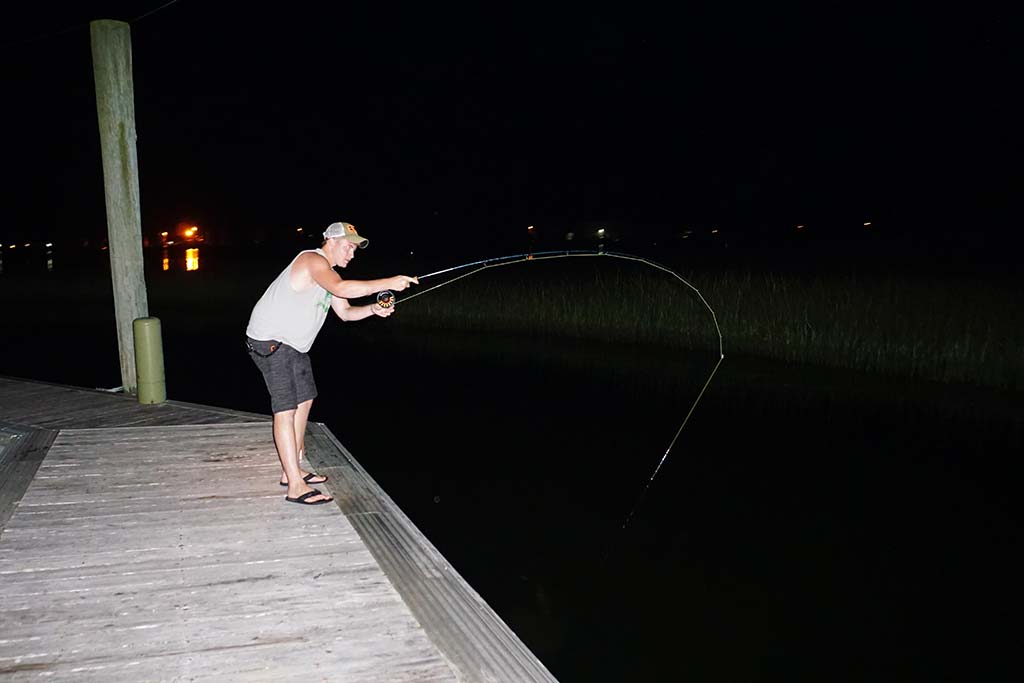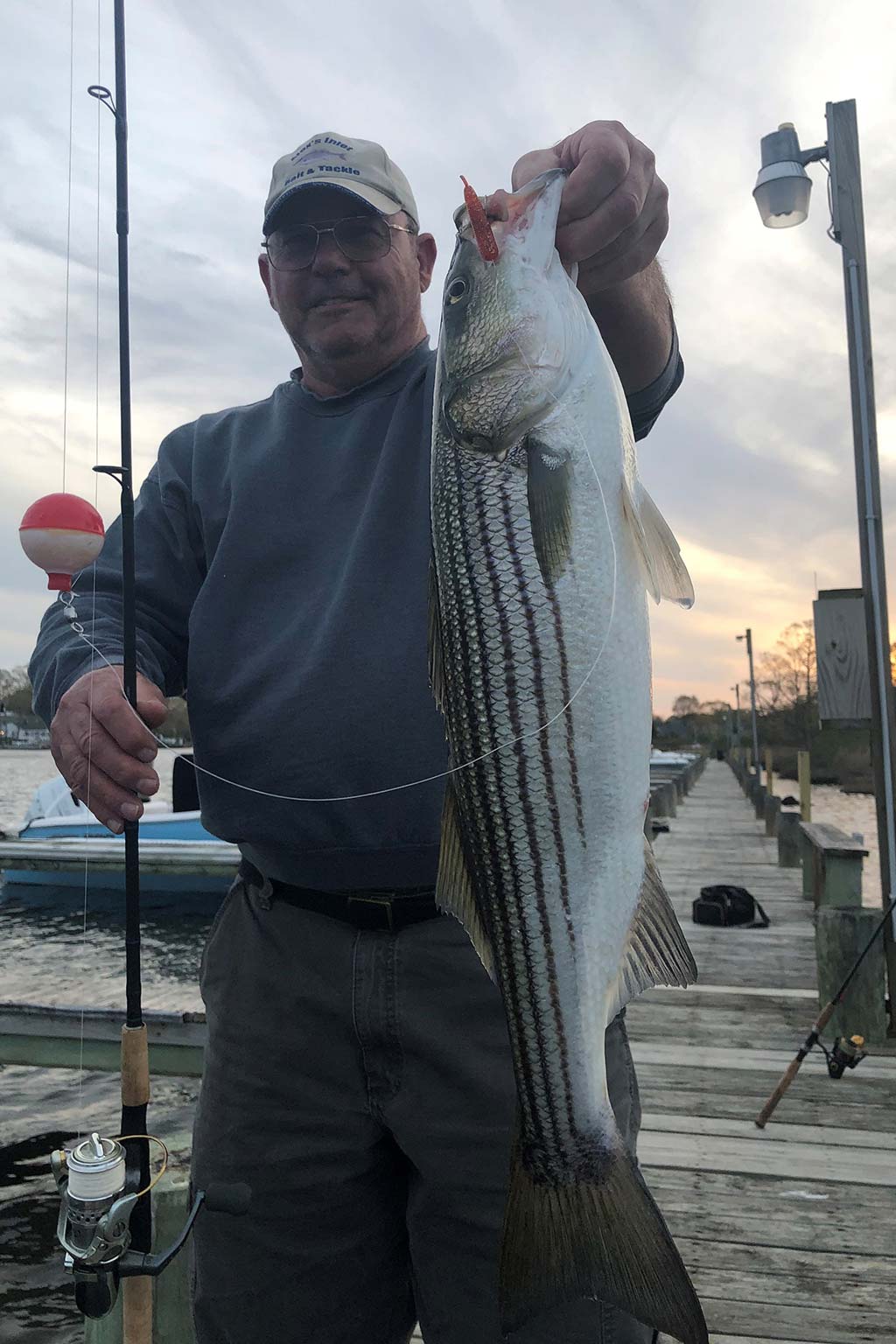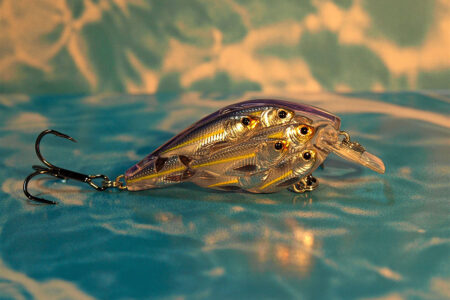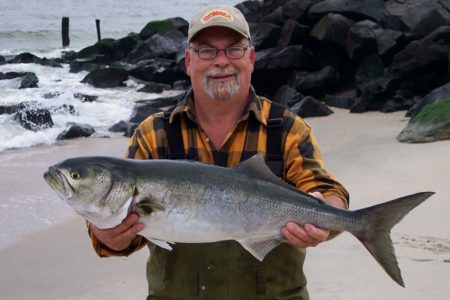
When the night’s magic seems anything but whispered and hushed.
Two nights after April’s full moon, the hair on my arms bristled at the sound of laughing gulls along a nearby creek. The day before I’d received an email from a reader who lives just south of me in northern Ocean County, a short video clip attached showing cinder worms skittering along the surface. Gathering up a light spinning outfit, a few short pieces of leader, trimmed plastic worms and a traditional bobber, I was fairly certain of what was making those black-headed birds cackle, and hopeful there were a few stripers in the mix as well.
If you’ve ever witnessed one of these worm hatches, you’ve probably seen the striped bass slurping and rolling along the surface. Standing on a dock at night during the hatch, it often sounds like logs being dropped in the water as fish methodically pick through these baits. Regrettably, there’s very little contemporary science written on these critters that I can find. Even some of the local researchers I know had difficulty finding much written on the subject. “Admittedly, I hadn’t heard about cinder worms until a few years ago,” said Douglas Zemeckis with Rutgers University, adding “A colleague from our Monmouth County Extension Office lives on the Metedeconk and first told me about them in 2017 when I started this position.”
“I can’t find much biological info on the species, which appears to be most typically reported as Nereis Limbata, or the synonymous scientific name of Alitta Succinea,” Zemeckis added.

A Run, Not A Hatch
Based on Dr. Zemeckis’ reference and referring to a study he sent, the cycle of worms found in the back bays at different points during the lunar cycle is not actually a “hatch” but a spawning event. In a paper out of Woods Hole, MA in the early 20th century about the breeding habits of the heteronereis form of Nereis Limbata, researchers Frank R. Lillie and E.E. Just describe the event in terms of “swarms” and “runs” during peak times when these worms are mating.
“The animals may be taken after sunset on certain nights, in general during the ‘dark of the moon’ in the months of June, July, August and September,” Lillie and Best wrote, adding “they appear swimming near the surface of the water very soon after sunset, and may be attracted by the light of a lantern.”
The “dark of the moon” of course is the time of a new moon when light is absent from the sky, but these swarms of cinder worms is most prevalent locally in the days immediately following the full moon, and earlier in New Jersey (April and May) than identified up in the Massachusetts study. However, this same paper noted, “they therefore occur in four periods or ‘runs,’ during the summer, corresponding to the lunar cycles.”
“Each run begins near the time of the full moon, increases to a maximum during successive nights and sinks to a low point about the time of the third quarter, then rises and falls to extinction shortly after the new moon,” the paper noted. Thus, the worm “run” is not actually a hatch but a mating ritual that occurs based on the lunar cycles. When a cyclical worm run is underway, swarms of mature males and females gather for a brief period of time during the nights following a new or full moon.
John A. Tiedemann, assistant dean at the School of Science at Monmouth University said these worms, also known as bristle worms, are members of the class Polychaeta which includes other species of worms familiar to anglers like sandworms and bloodworms. “Although they are burrow dwelling deposit feeders, they undergo a transformation to a swimming stage during spring or early summer in response to environmental triggers including water temperature, photoperiod, and lunar phases,” said Tiedemann, explaining how sexually immature cinder worms transform into sexually mature individuals through growth of hair-like bristles which enhance swimming ability.
“Once this transformation occurs the mature worms swim to the surface, commonly at night in response to the moon phase, and they release their eggs and sperm as they swarm on the surface,” Tiedemann said. This swimming stage and spawning event typically only lasts a few days, and which point Tiedemann said it is believed that spawning individuals die post-spawn. “Once fertilized, eggs hatch and undergo a series of planktonic larval stages before metamorphosing into adults,” he added.

Match The Swarm
I’d been frustrated by these swarming cinder worms before. During the summer of 2017 I began getting a flurry of texts from Dan DiPasquale who was whacking short stripers on a nightly basis somewhere behind Long Beach Island. He said the action had started sometime over the prior weekend during a short period of time under the dock lights and along the local sedges as bass were rolling on bait during the late summer evenings.
These weren’t big fish mind you; but with a good two months to go before the fall run was set to begin at the Jersey Shore, downsizing gear for a nighttime flurry of striped bass seemed like a good bet. It was a little before midnight and three days after the August new moon when I arrive, as Danny was already buttoned up to a shortie near the dock lights, while I saw Jimmy Buonanno pulling a fly rod out of his truck. I knew I was in for a little education.
For sure, fly fishermen have the edge in this fishery; the troubling aspect is getting casts in around bulkheads and pilings which in many ways at the Jersey Shore are a necessary evil in terms of access to the hatch. It didn’t take long before Jimmy was tied in to a schoolie while I rooted around for any piece of plastic in my box that could match.
An online search can find you a cinder worm fly imitation or two; a red, wooly bugger style would no doubt fit the bill, though one fly guy once advised me to try a pink saltwater gurgler style popular with Alaskan salmon. Staring down into the water and watching cinder worms flitting about I tend to think of a pink pipe cleaner of about an inch or so in length.
Noted fly tier Bob Popovics told me he never really got on those worm hatches in Barnegat Bay, saying the hatches were typically out of reach for the waders along the west side of Island Beach. “If I couldn’t observe the bait close at hand, I could never imitate the phenomenon,” Popovics said, adding “We just used Cap Colvin’s Ka-Boom-Boom poppers and did quite well.”

Back To Basics
As a knuckle dragging spin guy, I had spent more than a few fishless nights on these so called cinder worm hatches, stripers slurping and rolling on the surface buffet while my own offerings would go continually untouched, cast after endless cast. A couple of seasons back, a couple of my neighborhood buddies, Bob and George, were headed over to a local dock as those laughing gulls shrieked. A bit to my surprise, they each had red over white bobbers attached to their lines which caused me laugh to myself a bit. But as my buddies caught school stripers out of the melee on each of their 20th or so casts, I found I was only laughing at myself at that point.
It was pretty simple really; main line to a small barrel, then a short piece of 20- to 25-pound leader, about 2 to 3 feet in length. Use the smallest hook you can get away with considering the stripers may be anywhere from 15 inches to the potential of 15 pounds in the mix on rare occasions. On that hook try a small red, red/white or pink rubber worm. I can’t tell you what Bob and George use, as I’m still sworn to secrecy. But I can say that author Jim White who wrote the definitive book of soft plastics (How To Fish Plastic Baits in Saltwater) recommends the 3-inch Lunker City Slug-Go in bubblegum.
The bobber can go right above the barrel and serves two purposes; first it allows better casting of that un-weighted plastic, while also allows your hooked offering to stay up near the surface on a slow retrieve. Instead of the bobber, a more traditional tool for deployment would be the “casting egg” which has an eyelet on either end of the float for attaching the main line and the leadered rig. I’ve not used it, but I know Al Gag’s Lures has a rigged casting egg for around $20. Try a short piece of old broom handle or cork from a large bottle, center-wired with barrels at both end; even traditional snapper poppers will keep those baits up high in the water column.

A slow retrieve is all you need, a stop or start from time to time. When these striped bass show up to feed on the worms, they’re pretty much keyed in on those baits exclusively; the clearer the water, the more you want to consider hook size and how your bait looks on the retrieve. The better you can match the worms, their size, coloring and mating behavior, the better your chances of hookups. It’s helpful to watch these worms skitter and dance, etching that vision in your mind; trust me when I say you’ll find yourself looking at rubber worms and strip baits differently in the months ahead, ever tuned to simple modifications that can be made to present a more lifelike imitation under future moons.
It’s still a frustrating fishing experience to cast through as fish may appear to swirl and slap all around your offering. And occasionally you’ll feel a slight, split-second pull with no solid jerk to set upon; it seems to be nature of the feed. But when you can get that solid hookup after 30 or 40 casts, even a barely sublegal striped bass at your feet can feel like quite an accomplishment.
If you’re looking to find these worm swarms during the lunar runs of summer, try around the time of the new moon June 10, July 9, August 8 and September 6, or in the nights following the full moons of June 24, July 23, August 22 and September 20.
Some call muskie the fish of a thousand casts, as the challenge of just one hookup drives anglers to all parts of North America looking for a shot. In many of our backyard creeks and estuaries behind the Jersey Shore, you could cast a small black swimmer a thousand times and still not hook a striper out of a mating whirlwind of cinder worms. Through some trials and tribulations however, you can reduce the effort a bit and still find reason to celebrate a fantabulous night of summer schoolies during this spring and summer moon dance.




